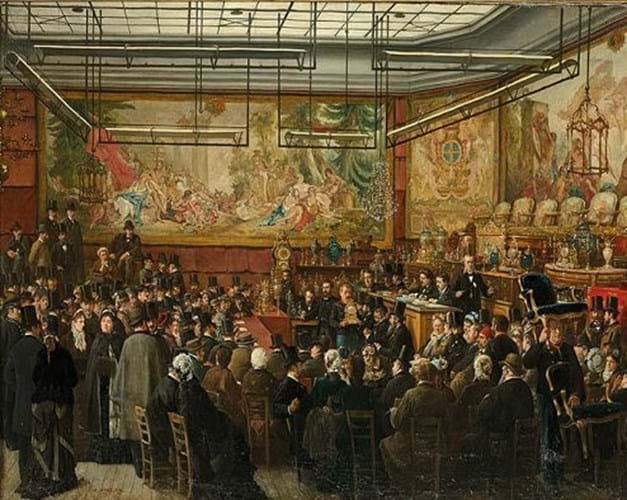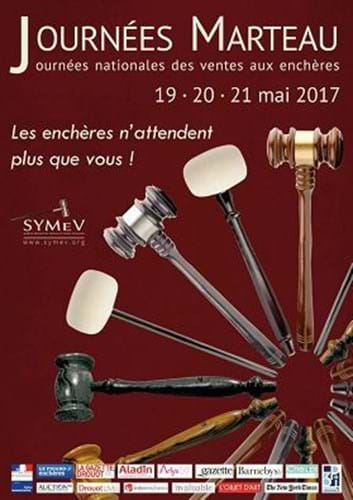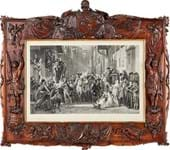
When you enter a French saleroom, some differences are immediately obvious. Others are hard to detect and stem from regulations going back beyond the Code Napoleon to a decree of Henri II in 1556.
While London auctioneers Sotheby’s and Christie’s forged ahead with full-scale commercial operations from the 1970s onwards, French auctioneers (known as commissaires-priseurs) were both protected and hampered by their status as government-appointed and regulated ‘adjudicators’ of auction sales, rather than free-wheeling entrepreneurs.
Only qualified French commissaires-priseurs could conduct auctions in France until 2001, when commissaires-priseurs were given new freedoms and foreign auction houses such as Sotheby’s and Christie’s were finally permitted to compete with them on their home turf.
This has bought changes but many of the French traditions and laws still govern auction practice.
“ When you enter a French saleroom, some differences are immediately obvious
1 The gavel
The first thing you might notice at a French sale is the auctioneer’s gavel (or marteau). This is a long and slender affair, wielded in metronomic style not unlike a conductor’s baton.
When the bidding finishes, lots are said to be ‘adjugés’ in quasi-judicial style rather than knocked down and ‘sold’.
Even the spotting of bidders is often left to another saleroom employee known as a ‘crieur’.

This year’s poster for the French auctioneers’ Journées Marteau organised by the French auctioneers association SYMEV, showing the French style of gavel or marteau.
2 Experts and auctioneers
The rather detached role of the French auctioneer is further demonstrated by the presence in the saleroom of an ’expert’.
Experts are independent specialists (often dealers) who are separately licensed and regulated and are principally responsible for cataloguing.
3 Regulation
Despite the freedom they acquired in 2001, French auctioneers are still tied up in bureaucracy. Since 2001 there have been two classes of auctioneer: Commissaires-Priseurs Judiciare and Commissaires-priseurs de ventes volontaire.
Auctioneers conducting a vente judiciare (a court-order sales of bankrupt stock or the like) are appointed by the court and answerable directly to a government department.
Auctioneers wishing to hold ventes volontaires must register with an independent governing body known as the Conseil des Ventes. They enjoy greater freedom in competing for business, marketing and other overtly commercial activities.
4 Joint action
To represent their own interests, the opérateurs de ventes volontaires have a trade association SYMEV (The syndicat national des maisons de ventes volontaires).
The group also organises an annual nationwide promotion of auctions to the general public each spring, known as the Journées Marteau.
5 The Drouot
Collectivism has always been part of the Paris auction scene.
Though there are more than 70 independent commissaires-priseurs in Paris, all have the right to hold their sales at the Drouot, a purpose-built auction centre on the Right Bank in a quarter where many auctioneers have their offices.
Nothing like Drouot exists in the UK, or anywhere else. It houses a surprising number of separate auction rooms and, with multiple sales being held in adjoining rooms by different firms, the first impression is of organised chaos.
Viewing at Drouot can be similarly daunting for the newcomer. Most sales are held in the afternoon. They are normally on view the day before, but for one hour only on the morning of the sale. Expect to be swept in with the crowd of waiting dealers when the doors open.
So Drouot is a hive of activity during the peak seasons, but not in the summer. While much of Paris shuts down for August, Drouot hangs up its gavel from mid-July to mid-September.
“ Even the spotting of bidders is left to another saleroom employee
6 Outside Paris
Sales at Drouot are held during the week, and never on a Sunday, but outside Paris they are very much part of le weekend.
You can expect a lively afternoon crowd of local bargain hunters, and do not be surprised if you encounter ventes courantes (sales without catalogues), where you are on your own when it comes to assessing authenticity and value.
7 Museums have the final say
Finally, it is worth remembering that in France the highest bidder is not necessarily the buyer. Since 1921 French museums and institutions have been able to pre-empt any lot immediately after the adjudication, buying it at the hammer price.
Some Useful Words
■ enchère: bid (aux enchères = at auction, enchérisseur = bidder)
■ commissaire-priseur: auctioneer
■ étude: auction house
■ frais: premium
■ crieur (aboyeur): bid-spotter
■ SVV: société de ventes volontaires (commercial auction house)
■ ventes courantes: uncatalogued sales
■ vente judiciaire: court-order sale
■ expert: a specialist called in to catalogue the sale.














